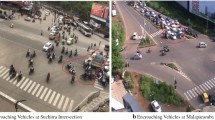Abstract
Saturation flow under mixed traffic conditions is affected by vehicular mix and its characteristics, approach grade, driver behaviour, roadway geometry, and road side frictions in the vicinity of intersection. Side friction arises from pedestrian movement, activities of public transport vehicles, and parking of vehicles on road premises. Due to the influence of these factors, realistic estimation of saturation flow is a complex task under heterogeneous traffic conditions. Road side friction arising from stopping of public transport adjacent to signalised intersection tends to interfere with vehicular discharge at intersections. This paper attempts to analyse the impact of far side (down stream side) and near side (upstream side) bus stops on saturation flow rate. As a first step towards quantifying the effect of bus stops, saturation flow of approaches that satisfies the base conditions set for the study were estimated in PCU/hr using area occupancy concept. Mathematical model for the prediction of base saturation flow was proposed. Effect of bus stops on saturation flow rate was then determined by analysing saturation flow rates of approaches where bus stops are located adjacent to intersections. Adjustment factors were introduced to incorporate the effect of far side bus stop (Ffb) and near side bus stop (Fnb) on saturation flow rate. Linear regression models were developed for the prediction of adjustment factors based on data generated using a micro simulation programme. The results of the study showed that adjustment factors vary with distance of bus stop from stop line, width of approach and proportion of green time blocked. The study also revealed that the reduction in saturation flow rate is more when bus stops are located in the upstream side (near side bus stop).






Similar content being viewed by others
References
Highway Capacity Manual (HCM) (2010) Special Rep. No. 209, 5th edn. Transportation Research Board, National Research Council, Washington, DC
Indo -HCM (2017) Indian highway capacity manual (Indo-HCM). CSIR-Central Roads Research Institute, New Delhi
Branston D, Zuylen HV (1978) The estimation of saturation flow, effective green time and passenger car equivalents at traffic signals by multiple linear regression. Transp Res 12(1):47–53
Branston D, Gipps P (1981) Some experiences with multiple regression method estimating parameters at the traffic departure process. Transp Res Part A 16A:445–458
Kimber RM, McDonald, Hounsell NB (1986) The prediction of saturations for road junctions controlled by traffic signals, Department of Transport, Transport and road Research Laboratory (TRRL), Research report 67. Her Majesty’s Stationery Office, London, pp 1–14
Arasan VT, Jagadeesh K (1985) Effect of heterogeneity of traffic on delay at signalized intersections. J Transp Eng 121(5):397–404
Chandra S, Sikdar PK, Kumar V (1996) Capacity analysis of signalised intersections. Highw Res Bull 54:129–152
Hossain M (2001) Estimation of saturation flow at signalised intersections of developing cities: a micro-simulation modelling approach. Transp Res Part A Gen 35(2):123–141
Raval NG, Gundaliya PJ (2012) Modification of Webster’s delay formula using modified saturation flow model for non-lane based heterogeneous traffic conditions. Highw Res J 5(1):41–48
Sigua RG (1995) Effects of uncontrolled loading and unloading of jeepenys/buses on the capacity of signalised intersections. J East Asia Soc Transp Stud 1(3): 1–9
Holt LD (2004) The effects of bus stops on the saturation flow rate of signalised intersections. Ph. D Thesis, North California University, 2004
Ghasemlou K, Aydin MM, Tanyel S, Topal A, Caliskanelli SP (2011) Effect of dwell time on performance of signalised intersection. In: 10th International congress on advances in civil engineering. Ankara, Turkey, 2011, pp. 1–24
Tuffour YA, Yeboah AO, Salifu M, Acquah PC (2012) Adjusting for the effect of bus blockage on saturation flows. Int J Sci Res (IJSR) 3(6):1–6
Cho H, Lee JJ (2014) A study on the capacity analysis method for signalized intersections for the effectiveness analysis of exclusive median bus lanes, TRB Annual Meeting 2014
Saha A, Chandra S, Ghosh I (2017) Saturation flow estimation at signalised intersections under mixed traffic conditions. Urban Transport XXIII, 2017, pp 387–393
Arasan VT, Dhivya G (2008) Measuring heterogeneous traffic density. In: Proceedings of international conference of sustainable urban transport and environment, World Academy of science, Engineering and Technology, Bangkok, 2008, pp 342–346
Mallikarjuna CH, Rao RK (2006) Area occupancy characteristics of heterogeneous traffic. Transportmetrica 2(3):223–236
Preethi P, Ashalatha R (2017) Estimation of saturation flow under heterogeneous traffic conditions. Proc Inst Civil Eng Transp. https://doi.org/10.1680/jtran.16.00088
Dhamaniya A, Chandra S (2013) Concept of stream equivalency factor for heterogeneous traffic on urban arterial roads. J Transp Eng 139(11):1117–1123
Planning Transport Verkehr (PTV) (2013) VISSIM users manual, version 7. PTV AG, Karlsruhe
Mathew TV, Radhakrishnan K (2010) Calibration of microsimulation models for nonlane-based heterogeneous traffic at signalized intersections. J Urban Plan Dev 136:59–66
Siddharth SMP, Gitakrishnan R (2013) Calibration of VISSIM for Indian heterogeneous traffic conditions. Proc Soc Behav Sci 104:380–389
Acknowledgements
The authors acknowledge the opportunity provided by the 4th Conference of the Transportation Research Group of India (4th CTRG) held at IIT Bombay, Mumbai, India between 17th December, 2017 and 20th December, 2017 to present the work that forms the basis of this manuscript.
Author information
Authors and Affiliations
Corresponding author
Rights and permissions
About this article
Cite this article
Prathapan, P., Rajamma, A. Determination of Adjustment Factors for Far Side and Near Side Bus Stops on Saturation Flow. Transp. in Dev. Econ. 4, 12 (2018). https://doi.org/10.1007/s40890-018-0065-1
Received:
Accepted:
Published:
DOI: https://doi.org/10.1007/s40890-018-0065-1




